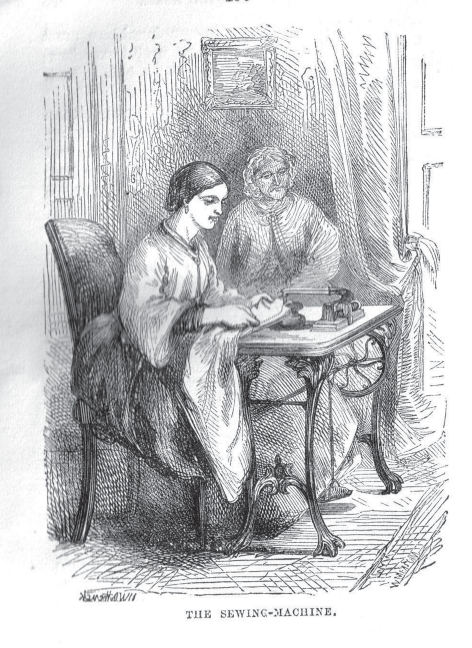The Invention of the Sewing Machine
An Alternative History
ISMACS News
Issue 84
June 2006
by martin Gregory

The little woodcut of a sewing-machine which accompanied the story looks like a poor attempt at a Wheeler and Wilson sewing machine! - M G
'Alternative history' is rather popular at present with authors trying to rewrite the documented history of events. To show that this is not new, here is an 'alternative history' of Howe's invention of the sewing machine culled from the July 1865 issue of the Child's Companion and Juvenile Instructor, price one penny and published by The Religious Tract Society. Here is a moral story for little girls written in Elias Howe's lifetime!
Our little girls must learn to use the needle, and hem, and sew, and make button holes, in spite of sewing-machines; for I have not heard whether sewing-machines can darn or patch, or do all the work that is to be done. So our daughters must learn to use the needle for these useful exercises; otherwise, they may have to go with a hole in their stockings, or a torn dress.
They say the needle has killed more people than the sword. Can that be so, I ask, looking at our children so happy over their patchwork? To find out whether this is true, let us look into the dark garrets and back alleys of the great cities. There should we find hundreds and thousands of poor, pale, sickly women, trying to earn their living by their needle. Some of them have dear little children to feed and clothe; and, in order to do this, they have to sit and sew sixteen hours a day, and perhaps get only a few pence for all their toil. It is only "stitch, stitch, stitch," from morning till night, day after day, with very little bread to eat even then. No wonder they die of it. So the needle has killed a great many people, I have no doubt. I cannot tell you how grieved some kind people were when they first heard of this sad state of things. They used to form societies to help these poor women; but societies could not stop the difficulties.
At last a strange little friend came to their help. And what should it be but a sewing-machine! While the poor London sewing women were starving to death, a man in America, seeing how many stitches his poor wife had to make for her little family, wondered if he could not make a machine to do her sewing. He puzzled his brains a good deal about it. In the evening, after he came home from his day's work, he took his tools, and put his ideas into wood, and into iron, and wheels; and out of it all, sure enough, came a machine that could use a needle. That pleased his wife. The man's name is Elias Howe. He showed it to some of his friends, who said "it was capital. Get the invention patented, Elias." And Elias did. That was in 1846.
All the sewing machines which we hear of sprung from that. Improvements of course have been made; and now a machine in full working order can not only sew, but turn down a hem, put on a binding, plait a flounce, and sew it on better and quicker than the most expert needlewoman.
Many women at first were put out of work by the sewing-machine, but others were helped into work by it. In the end it will, no doubt, work for the good of all classes. Thus we see how new inventions turn out in the end to the good of mankind.
If you do not know the real story of Elias Howe, start with Grace Rogers Coopers's book The Sewing Machine: its invention and development, or the article on Elias Howe in Wikipedia. http://en.wikipedia.org/wiki/Sewing_machine. Previously published articles about Howe can be found on the ISMACS website https://ismacs.net/howe/home.html





